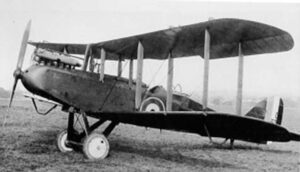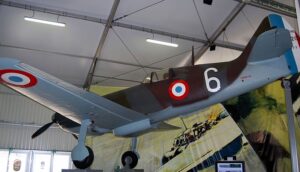Time Period: World War I
Country of Origin: United Kingdom
Type: Biplane, Fighter Aircraft
Manufacturer: Airco
Airco DH.2 Aircraft Overview
The Airco DH.2 was designed by Geoffrey de Havilland and built by the Aircraft Manufacturing Company (Airco) during World War I. It was introduced in 1915 and was the first successful British fighter aircraft to have a forward-firing machine gun, which gave it a significant advantage over its contemporaries.
The DH.2 featured a wooden frame and was powered by a 100-horsepower Gnome Monosoupape rotary engine. It was armed with a single .303 inch (7.7 mm) Vickers machine gun mounted on the top wing, which was synchronized to fire through the propeller arc. This allowed the pilot to aim and fire the gun directly at enemy aircraft rather than relying on firing a gun mounted to the side of the plane.
The DH.2 had a top speed of 93 mph (150 km/h) and a ceiling of around 15,000 ft (4,600 m). It was very maneuverable and could outclimb most other aircraft of the time. The DH.2 was widely used by the Royal Flying Corps and played a significant role in the air war over the Western Front in 1916.
A total of 453 DH.2 aircraft were built, making it one of the most successful British fighter aircraft of World War I. Its success paved the way for the development of other aircraft in the DH series, including the DH.4 and DH.9 bombers and the DH.5 and DH.6 fighters.
Airco DH.2 Specifications
- Crew: 1
- Length: 25 ft 2+1⁄2 in (7.684 m)
- Wingspan: 28 ft 3 in (8.61 m)
- Height: 9 ft 6+1⁄2 in (2.908 m)
- Wing area: 249 sq ft (23.1 m2)
- Empty weight: 943 lb (428 kg)
- Gross weight: 1,441 lb (654 kg)
- Powerplant: 1 × Gnôme Monosoupape 9-cylinder rotary engine, 100 hp (75 kW)
- Propellers: 2-bladed Integral DG 70 fixed pitch wooden propeller.
Airco DH.2 Performance
- Maximum speed: 93 mph (150 km/h, 81 kn) at sea level
- Endurance: 2 hours, 45 minutes
- Service ceiling: 14,000 ft (4,300 m)
- Time to altitude: 24 minutes, 45 seconds to 10,000 ft (3,000 m)
Airco DH.2 Armament
- Guns: One × .303 in (7.7 mm) Lewis gun.
- Rockets: Two examples were equipped with Le Prieur rockets for attacking observation balloons.
Airco DH.2 Image Gallery
More Airco Aircraft

Airco DH.9A
The Airco DH.9A is a British light bomber used shortly before the end of the Great War (WW1). It featured a strengthened structure and Puma engine.

Airco DH.9
The Airco DH.9 is a British single-engine biplane developed and used during World War I. It was ordered in large numbers by the RFC.

Airco DH.6
The Airco DH.6 is a two-seat biplane introduced in 1916 and used during World War I for training pilots and observers.

Airco DH.5
The Airco DH.5 is a single-seat biplane fighter aircraft first introduced in 1917 to replace the DH.2 and similar outdated designs.

Airco DH.4
The Airco DH.4 is a two-seat biplane airplane designed by Airco for World War I. It became one of the most successful planes of the war.









